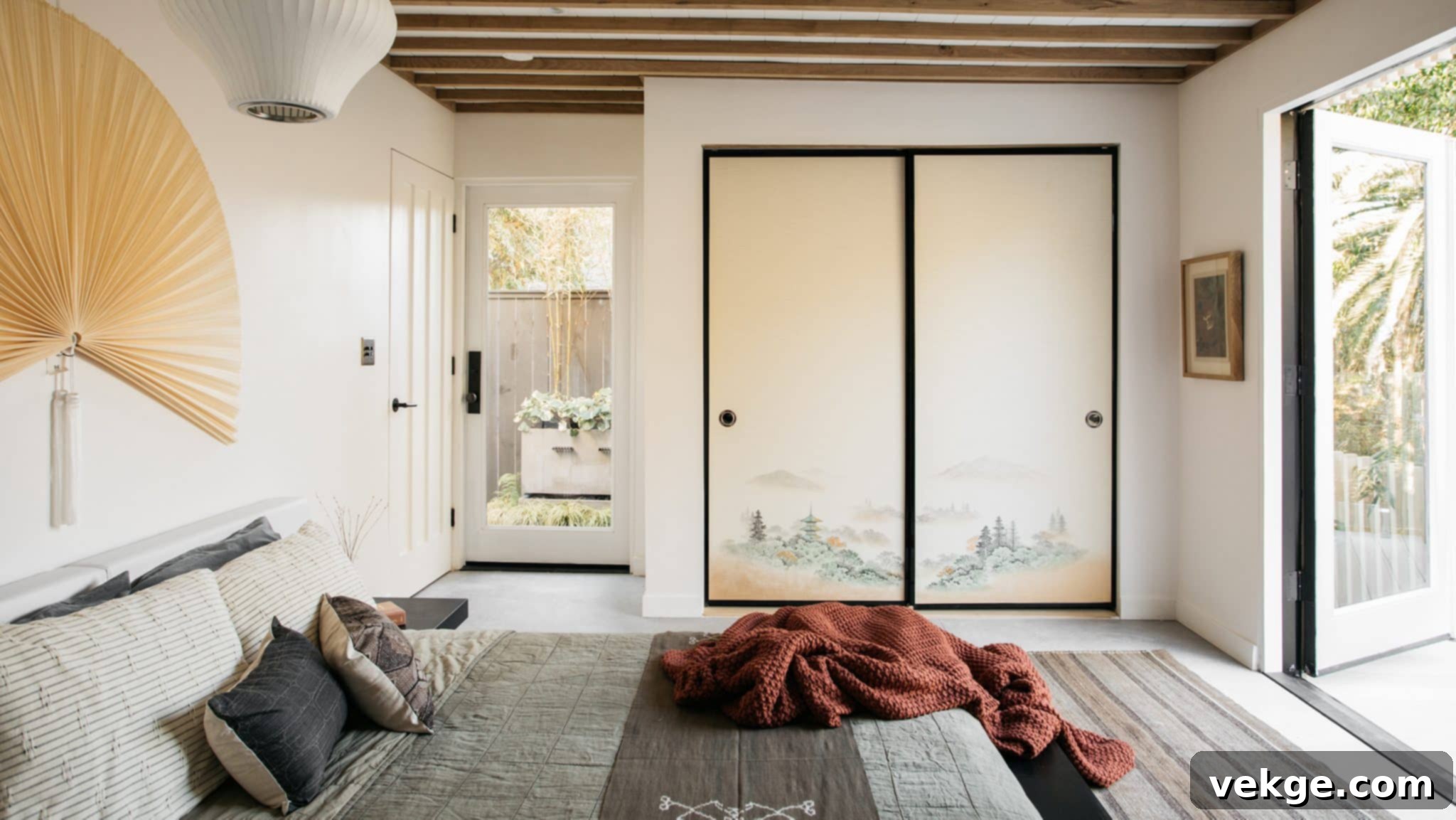Embrace Serenity: Your Ultimate Guide to Japandi Interior Design
Japandi, a captivating interior design aesthetic, masterfully blends the refined elegance of traditional Japanese design with the cozy functionality of Scandinavian furnishing. Often referred to as ‘Scandinise,’ ‘Japanordic,’ or simply ‘Japanese minimalism with a Nordic twist,’ this style has garnered immense popularity for its unique ability to create spaces that are both deeply calming and incredibly practical.
At its core, Japandi draws from the shared foundational principles of two distinct cultures. Despite their obvious geographical and cultural differences, both Scandinavia and Japan share a profound appreciation for efficiency, thoughtful minimalism, and a deep reverence for nature and meticulous craftsmanship. This harmonious convergence results in an aesthetic that feels inherently balanced, warm, and utterly timeless.
A Japandi interior immediately conveys an impression of serene tranquility, as if touched by peace and understated beauty. It speaks volumes of Japanese aesthetics without explicit declaration and evokes the comforting embrace of Scandinavia, regardless of your physical location. This design philosophy finds common ground with Zen philosophy, advocating for an unburdened approach to home décor. The goal is to cultivate an abode that is both stunningly beautiful and inherently minimalist, reflecting a thoughtful curation rather than excessive accumulation.
Are you intrigued by the allure of Japandi and eager to infuse your living spaces with its unique vibe? Below, we explore key principles and practical steps to help you transform your home into a serene Japandi sanctuary.
1. Embrace Warm, Muted Color Palettes in Japandi Interior Design
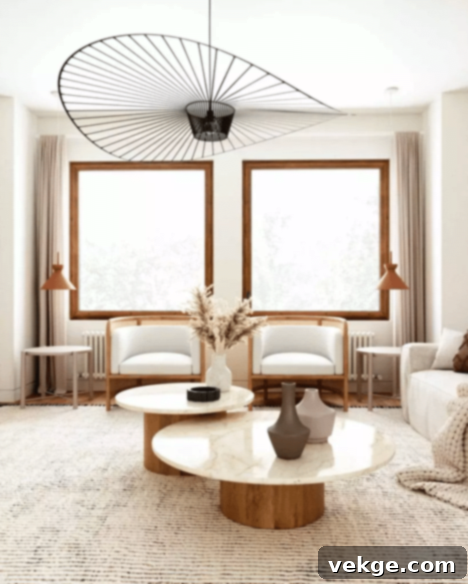
The foundation of any Japandi space begins with its color palette. Scandinavian design often leans towards cool neutrals like grey, white, and subtle browns, creating a bright and airy atmosphere. Conversely, traditional Japanese aesthetics favor pastel shades inspired by the sky, lush plants, and rich earth tones, bringing nature indoors. Japandi expertly blends these influences, resulting in a palette of warm, muted colors that are both calming and inviting.
Think creamy whites, soft beiges, light greys, and earthy browns, punctuated by subtle natural greens and blues. These colors are chosen to create a natural, organic landscape within your home, evoking a grounded and peaceful feeling. Avoid stark, high-contrast colors or overly vibrant hues. Instead, opt for harmonious tones that complement each other, promoting a sense of flow and tranquility throughout your space. The aim is to create a backdrop that feels organic and allows natural textures and materials to truly shine.
2. Prioritize Craftsmanship and Natural Materials to Accentuate Japandi Style
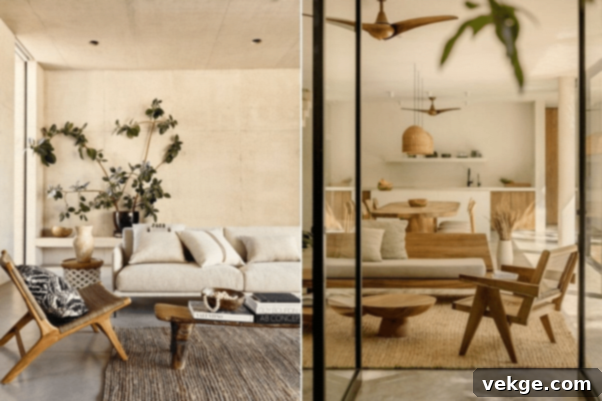
A cornerstone of Japandi aesthetics lies in its deep appreciation for craftsmanship and the inherent beauty of natural materials. This design philosophy champions items that feel handmade, possess a story, and reveal subtle imperfections, embodying the Japanese concept of Wabi-Sabi – finding beauty in imperfection and transience. Both Japanese and Scandinavian designs highly value sustainable, durable materials that will last, reflecting a respect for resources and a rejection of disposability.
Wood is a paramount material, celebrated for its versatility, warmth, and accessibility. Japanese furniture often features woods like Cedar (sugi), Red Pine (Akamatsu), and Cypress (hinoki), known for their distinct grains and light tones. Scandinavian design, on the other hand, frequently incorporates Oak, Ash, Beech, Pine, and Teak, often with lighter finishes that enhance their natural beauty. The combination in Japandi encourages a blend, where light woods from Scandinavia meet darker, richer Japanese tones to create dynamic visual interest without compromising the serene feel.
Beyond wood, incorporate other organic materials such as bamboo, rattan, ceramic, stoneware, linen, cotton, and wool. These materials add rich texture and an authentic connection to nature, contributing to the overall sense of calm and tactile comfort. Seek out furniture and decor items that showcase quality construction and a timeless design, rather than mass-produced, trend-driven pieces. Every item should feel thoughtfully chosen for its function and aesthetic value.
3. Embrace Simplicity and Functionality: Raw and Organic Elegance
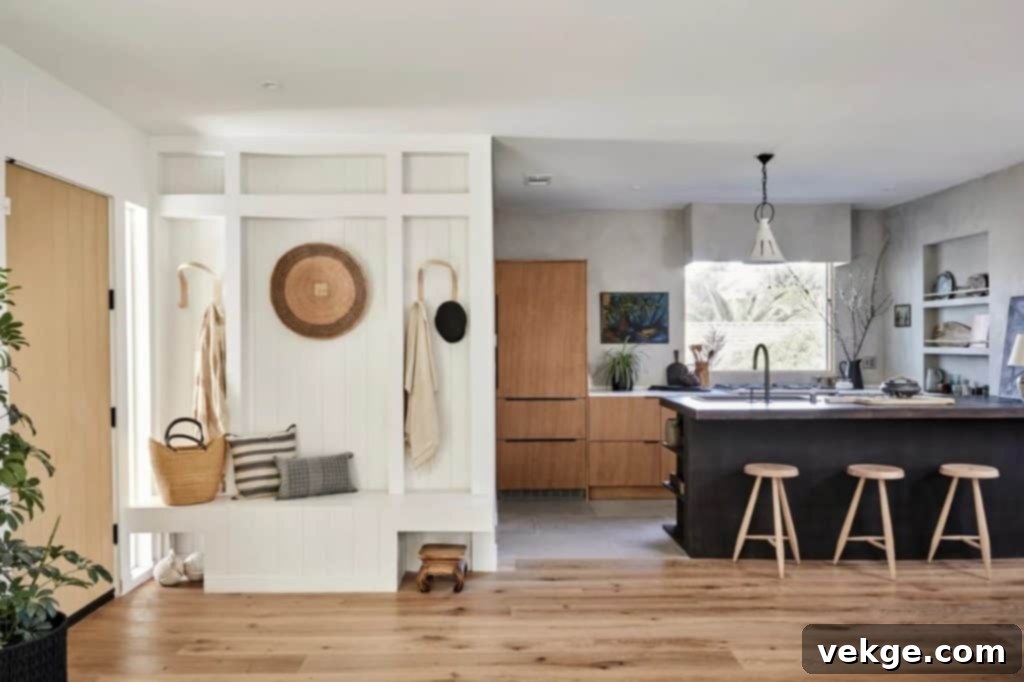
Japandi interior design champions a style that is inherently raw, organic, and beautifully understated. This aesthetic features solid, clean lines and shapes throughout all rooms, promoting a sense of order and visual clarity. The elements chosen for a Japandi space are cozy and substantial, yet they never clutter the environment. Instead, this design ensures utmost comfort and utility without sacrificing precious space or introducing visual noise.
The interiors imitate exceptional aesthetics while prioritizing functionality over superfluous frills. Every item serves a purpose, contributing to the overall harmony and ease of living. To implement Japandi décor in your room, focus on natural, textural elements that are both beautiful and practical. Consider textiles like hemp for throws or cushions, terracotta pots for plants, sisal rugs for grounding a space, and timber for furniture and architectural accents. These materials bring a sense of earthiness and authenticity, aligning perfectly with the Japandi ethos of living simply and beautifully.
4. Prioritize Comfort and Coziness for a Welcoming Japandi Home
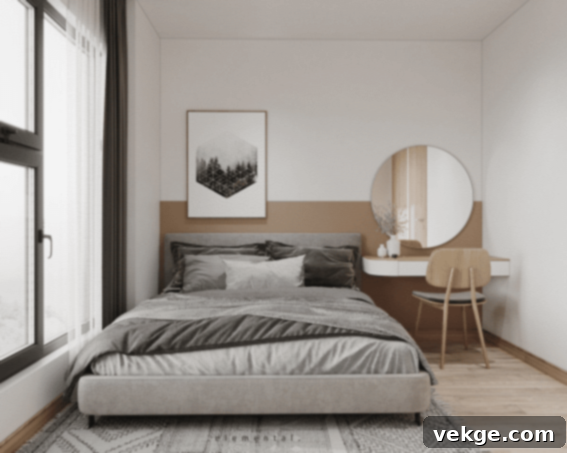
While minimalism is a core tenet, Japandi décor places an equally high priority on comfort and coziness, heavily drawing from the Scandinavian concept of Hygge. This isn’t about stark, cold spaces; it’s about creating an atmosphere of warmth, well-being, and genuine comfort. Every design decision should contribute to a feeling of relaxed ease and hospitality. Even minimalist designs can be incredibly inviting when thoughtfully executed.
In bedrooms, which are often the epitome of minimalist sanctuaries in Japandi homes, comfort reigns supreme. The bedding should be soft, luxurious, and inviting. Decorative accents are kept to a minimum – perhaps a few carefully chosen pieces of art that evoke calm, and a handful of plush throw cushions that add texture and a touch of warmth. The focus is on creating a restful retreat where one can truly unwind, free from unnecessary visual distractions. Think soft lighting, natural fiber rugs, and comfortable seating that encourages relaxation and contemplation.
5. Select Low-Profile and Functional Furniture for Japandi Appeal
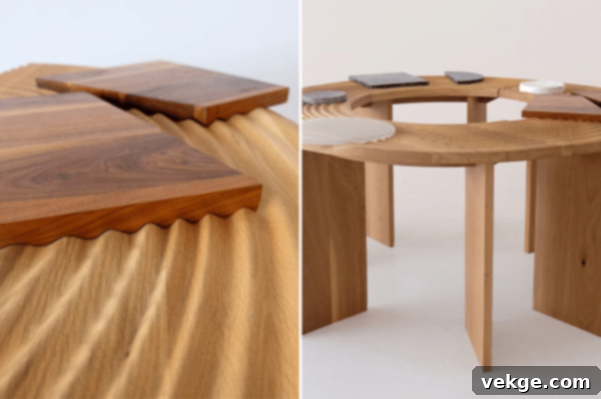
Furniture is arguably the most essential and impactful element in defining the Japandi style. It should be simple, functional, and display mild, natural hues. To create visual interest and prevent monotony, the surrounding décor should be kept minimal, allowing the quality and form of the furniture to truly stand out. This approach emphasizes quality over quantity, investing in well-crafted pieces that will endure both aesthetically and structurally.
One of the defining characteristics of Japandi interiors is the prevalent use of low-profile furniture. This design choice, deeply rooted in traditional Japanese seating customs, brings occupants closer to the earth, intensifying feelings of calmness and tranquility. It contributes significantly to the overall pleasant and serene look of a Japandi interior, creating an open and airy feel that promotes a sense of grounding and peace.
For wood types, Scandinavians commonly employ light woods like Oak, Ash, and Pine, while Japanese design frequently utilizes darker woods such as Cedar (sugi), Red Pine (Akamatsu), and Cypress (hinoki). To beautifully incorporate both wood tones into your Japandi home, create a subtle contrast between lighter and darker woods. For instance, pair light oak flooring with a dark walnut coffee table, or combine a pale birch dining set with darker, textured ceramic dinnerware. This thoughtful blending adds depth and sophistication without overpowering the minimalist aesthetic.
6. Cultivate an Inclination to Nature (Biophilic Design)

A profound connection to nature, or biophilia, is central to the Japandi philosophy. Both Scandinavian and Japanese design traditions hold deep respect for the natural world, and this reverence translates directly into home aesthetics. A Scandinavian-inspired home often features ample natural light and clean lines, providing a fantastic foundation for accentuating natural landscapes, whether through large windows or carefully chosen art.
While both cultures appreciate greenery, the Japandi style emphasizes fewer, yet larger and more sculptural plants. Instead of numerous small pots, opt for one or two substantial plants with delicate branches or interesting foliage, housed in large ceramic or terracotta pots. These become living art pieces, adding vibrant green accents and purifying the air without creating visual clutter. Complement this with sand-colored canvas art, minimalist line drawings, or abstract pieces that echo natural forms and muted tones.
Beyond plants, integrate other natural elements like stones, dried botanicals, branches, or a beautifully crafted wooden bowl. Maximize natural light and incorporate views of the outdoors whenever possible. The goal is to create a seamless transition between your indoor and outdoor environments, fostering a sense of peace and harmony that only nature can provide.
7. Extend Japandi Principles to Your Bathroom Sanctuary
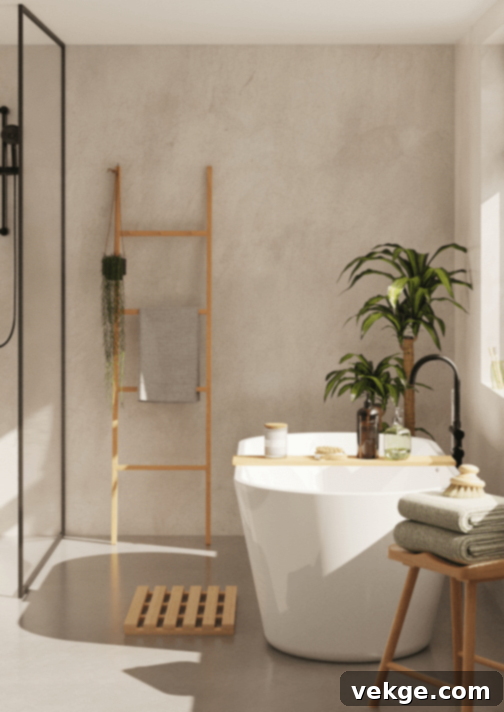
The Japandi style encourages extending its serene aura throughout your entire home, and the bathroom is no exception. Envision a bathroom that feels like a natural oasis, a space for ultimate relaxation and rejuvenation. To achieve this zen feeling, ensure your bathroom has ample space and is free from clutter, allowing you to move freely and treat your body with a sense of calm and unhurried ease.
Focus on clean lines, natural materials, and a functional layout. Consider using natural stone for countertops or shower walls, wooden accents for shelving or bath caddies, and simple, unfussy fixtures in matte black or brushed metal. If you have a bathtub, consider making it the centerpiece of your bathroom. A freestanding, minimalist tub with clean lines perfectly highlights both the Scandinavian emphasis on form and function and the Japanese appreciation for ritualistic bathing. Add a simple stool, a small plant, and soft, indirect lighting to complete this tranquil, spa-like environment.
8. Incorporate Simple, Thoughtful Pops of Color

While Japandi style emphasizes keeping everything minimal and predominantly utilizes a palette of muted, pastel colors, this doesn’t mean completely abstaining from color. Thoughtful integration of simple color pops can add personality and warmth without disrupting the overall serene aesthetic. The key is moderation and natural integration. Avoid overly bold or neon colors that would clash with the understated Japandi philosophy.
Instead of relying on items with busy patterns or complex designs, which might feel out of place, introduce color through natural elements or subtle textures. The best way to make colors stand out in your rooms while staying true to the Japandi spirit is to add a lush green indoor plant or a bright-colored carpet in a muted, earthy tone. A ceramic vase in a soft blue, a throw blanket in a deep rust, or a piece of abstract art with subtle color variations can all serve this purpose. These accents should feel organic and harmonious, enhancing the space rather than dominating it.
9. Consider Japandi Flooring: Hardwood and Natural Rugs
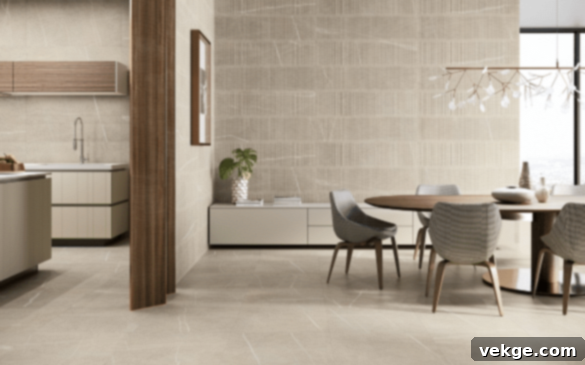
The flooring in a Japandi interior plays a crucial role in establishing the desired natural and grounded aesthetic. Hardwood is the predominant choice, offering warmth, durability, and a timeless appeal. You have the flexibility to choose either light or dark wood tones for your room, depending on the overall mood you wish to create. Lighter woods contribute to an airy, open feel, typical of Scandinavian spaces, while darker woods can ground a room with a touch of traditional Japanese depth.
Occasionally, you might see flooring laid in a herringbone pattern, which adds a subtle layer of visual texture and sophistication without appearing overly ornate. To enhance comfort and visual interest, layer your hardwood floors with natural fiber rugs. A beautiful natural rug, perhaps in a cream or muted earth tone, will offer a delightful contrast to deep-brown timber floors, adding softness underfoot and defining different zones within an open-plan space. Opt for rugs made from materials like wool, jute, or sisal for an authentic Japandi touch.
10. Master the Art of Creating Subtle Contrast
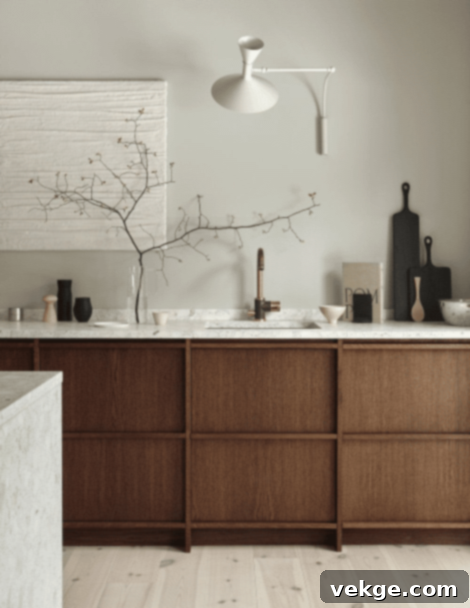
Achieving the ideal Japandi interior design involves a masterful use of subtle contrast. This isn’t about jarring differences, but rather about creating gentle distinctions that add depth, character, and visual intrigue to a minimalist space. Contrast can be introduced through various elements: color, texture, material, and form. For example, if your kitchen walls are painted in a light, nude pastel color, you can beautifully enhance the room’s aesthetic by adding a slightly darker shade of that nude color through accents or cabinetry.
Consider dark brown or black cabinets against lighter walls to make your kitchen appear more vibrant and sophisticated while remaining true to the Japandi design principles. Beyond color, play with textural contrasts: pair smooth, polished wood with rough, woven textiles like linen or wool. Combine sleek, modern ceramics with more organic, handmade pottery. The juxtaposition of light and shadow, soft and hard, new and aged, all contribute to a dynamic yet harmonious environment that is uniquely Japandi, preventing the space from feeling bland or sterile.
11. Enhance Japandi Interior Design With Thoughtful Wall Texture
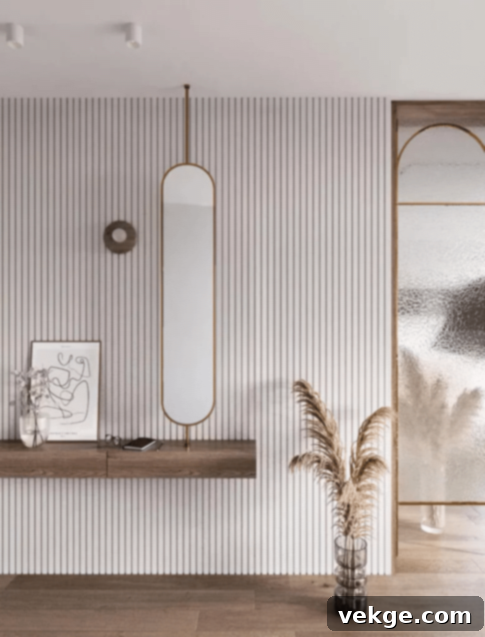
Wall treatment in Japandi interiors offers a fantastic opportunity to introduce subtle texture and depth, drawing inspiration from traditional Japanese homes. Often, Japanese houses feature walls crafted from natural materials like bamboo or cedar panels, embodying a connection to nature and exquisite craftsmanship. Japandi interiors project walls in a similar fashion, utilizing textures to give a plain area an aesthetic appeal that is both understated and sophisticated.
You can opt for walls with very minimal patterns and subtle textures, such as limewash paint which provides a soft, cloudy effect, or plaster finishes that offer a raw, organic feel. Alternatively, consider adding vertical wood strips, which beautifully enhance the Japandi culture by introducing architectural interest and a sense of natural warmth. These strips can be in a light wood tone for a Scandinavian touch or a darker wood for a more Japanese-inspired look. The goal is to create visual interest and tactile richness without resorting to busy wallpapers or excessive ornamentation. The texture itself becomes the art, inviting a closer look and adding a layer of sophisticated simplicity.
Conclusion: Your Path to a Serene Japandi Home
Japandi design represents a truly captivating blend, harmonizing the timeless elegance and meditative simplicity of ancient Japanese features with the inviting warmth and modern functionality of Scandinavian aesthetics. The unique ambiance that emerges from this fusion is a highly appealing aesthetic balance, perfectly suited for individuals who seek a style that effortlessly bridges Eastern and Western cultural philosophies.
By thoughtfully incorporating the core ideas of Wabi-Sabi – embracing imperfection and natural beauty – and Hygge – cultivating comfort and well-being – into your décor, you can design a home that is profoundly warm, exceptionally practical, and visually gorgeous. Japandi is more than just a trend; it’s a lifestyle choice that promotes tranquility, mindfulness, and a deep appreciation for the beauty of simplicity and the enduring quality of natural elements. Embark on your Japandi journey and transform your space into a sanctuary of calm and understated elegance.
